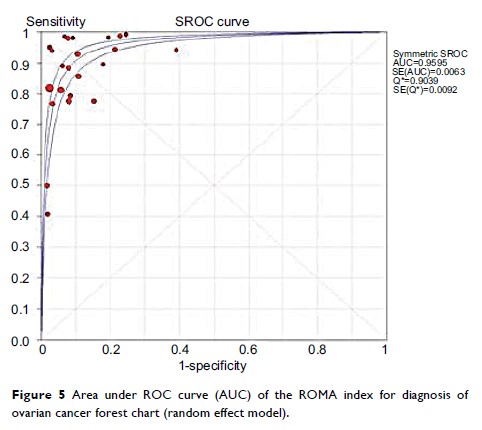9 9 6 5 3
论文已发表
注册即可获取德孚的最新动态
IF 收录期刊
- 3.3 Breast Cancer (Dove Med Press)
- 3.4 Clin Epidemiol
- 2.5 Cancer Manag Res
- 2.9 Infect Drug Resist
- 3.5 Clin Interv Aging
- 4.7 Drug Des Dev Ther
- 2.7 Int J Chronic Obstr
- 6.6 Int J Nanomed
- 2.5 Int J Women's Health
- 2.5 Neuropsych Dis Treat
- 2.7 OncoTargets Ther
- 2.0 Patient Prefer Adher
- 2.3 Ther Clin Risk Manag
- 2.5 J Pain Res
- 2.8 Diabet Metab Synd Ob
- 2.8 Psychol Res Behav Ma
- 3.0 Nat Sci Sleep
- 1.8 Pharmgenomics Pers Med
- 2.7 Risk Manag Healthc Policy
- 4.2 J Inflamm Res
- 2.1 Int J Gen Med
- 4.2 J Hepatocell Carcinoma
- 3.7 J Asthma Allergy
- 1.9 Clin Cosmet Investig Dermatol
- 2.7 J Multidiscip Healthc

ROMA 指数在卵巢癌诊断中的临床价值:荟萃分析
Authors Cui RL, Wang YC, Li Y, Li YG
Received 24 December 2018
Accepted for publication 4 February 2019
Published 28 March 2019 Volume 2019:11 Pages 2545—2551
DOI https://doi.org/10.2147/CMAR.S199400
Checked for plagiarism Yes
Review by Single-blind
Peer reviewers approved by Dr Amy Norman
Peer reviewer comments 2
Editor who approved publication: Professor Lu-Zhe Sun
Objectives: The role
of retrospective analysis has evolved greatly in cancer research. We undertook
this network meta-analysis to evaluate retrospectively the diagnostic value of
ROMA in ovarian cancer.
Materials and methods: We
systematically retrieved 56 relevant articles published about ROMA index from
2009–2018 and about ovarian cancer from China National Knowledge Infrastructure
(CNKI), PubMed and EMBASE. Data were comprehensively analyzed by RevMan 5.3 and
MetaDisc 12.4 software.
Results: Data of
5,954 cases were retrieved from 23 literatures. Among them, 2,117 cases were in
the ovarian cancer group and 3,837 cases in the control group. The pooled
estimates for the ROMA index were sensitivity: 0.90 (95% CI: 0.88–0.93),
specificity: 0.91 (95% CI: 0.89–0.94), positive predictive: 0.90 (95% CI:
0.88–0.95), negative predictive: 0.93 (95% CI: 0.91–0.95), and area under ROC
curve: 0.96, compared to 0.71 (95% CI: 0.56–0.82), 0.87 (95% CI: 0.80–0.92),
0.82 (95% CI: 0.78–0.86), 0.92 (95% CI: 0.90–0.94), and 0.88 of HE4,
respectively.
Conclusions: This
meta-analysis confirms that the risk of ovarian malignancy algorithm can
facilitate the diagnosis of ovarian cancer to some extent.
Keywords: ROMA
index, ovarian cancers, meta-analysis
